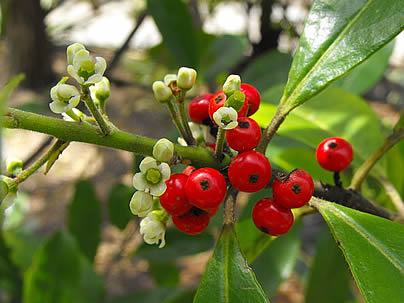Yerba mate (Ilex paraguariensis) is a dioecious, evergreen tree of small size, mainly known as the source of mate tea, chimarrão, and tereré, popular beverages in southern Latin America that have gained enthusiasts in various countries such as Syria, Japan, and the United States, etc. It is characteristic of the “Araucaria Forest” biome, found at altitudes above 1300 feet (about 400 meters).
It grows in the understory, benefiting from the shading of other trees, reaching up to 50 feet (approximately 15 meters) in height in these conditions, while in cultivation and under full sun, it rarely exceeds 23 feet (around seven meters) in height. It has an upright trunk with a final diameter of 8 to 20 inches (approximately 20 to 50 cm) and a rough, gray-brown bark with numerous lenticels. Its leaves are arranged alternately, simple, glabrous, petiolate, leathery, obovate, dark green, and serrated.
Yerba mate blooms in spring and early summer, producing corymbose and axillary inflorescences with small, simple, white flowers that are pollinated by insects. The resulting fruits are small, globular berries that turn red when ripe, containing four seeds. They are eagerly consumed by birds, especially thrushes, their main dispersers.
In landscaping, yerba mate is still relatively unexplored but is well-suited for the formation of informal hedges, especially in semi-shaded areas where other shrubs may struggle. They can also be used in woodlands alongside other tree species, in parks, and larger gardens. Despite its preference for the company of other trees, there is no hindrance to planting it in isolation or even in pots. Its use in reforestation areas is also valuable for attracting birdlife. It exhibits slow to moderate growth.
It should be cultivated in full sun or partial shade, in fertile, deep, permeable soil enriched with organic matter and irrigated in the first year of establishment. Young yerba mate seedlings should always be protected from strong sunlight. Provide initial shading and gradually remove it as the plant grows. In commercial cultivation, pruning the plant to keep it under 10 feet (approximately 3 meters) in height is recommended to facilitate leaf harvesting.
Yerba mate is not suitable for monocultures, where pests and diseases quickly establish themselves. It is the perfect crop for sustainable use, mixed with native species, timber, or fruit-bearing trees, such as pine and araucaria. For use as a living fence, formative pruning is necessary to encourage plant thickening. Fertilize semi-annually with organic fertilizers and slow-release fertilizers. It is challenging to propagate through cuttings and seeds, which should be harvested from mature fruits and stratified for 5 to 6 months in damp sand before planting.


